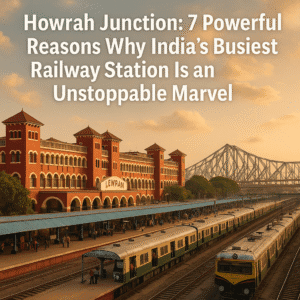Howrah Junction: 7 Powerful Reasons Why India’s Busiest Railway Station Is an Unstoppable Marvel
Howrah Junction in Kolkata, not New Delhi or Mumbai, holds the title of India’s busiest railway station, handling over 600 trains and a staggering one million passengers daily across its 23 sprawling platforms. Established in 1854 as India’s oldest station, it’s a vital historical and architectural landmark, designed by Halsey Ricardo with a distinctive red-brick colonial facade blending Victorian and Gothic styles. Serving as Eastern India’s indispensable rail gateway, it connects West Bengal to the entire nation.
Its iconic identity is inseparable from the mighty Howrah Bridge spanning the Hooghly River, linking it directly to Kolkata. More than just infrastructure, Howrah is a living microcosm of constant motion and a profound testament to India’s railway heritage, where the weight of history mingles palpably with the relentless energy of modern travel. Its scale and enduring significance make it the undeniable, thrumming heart of the region’s transport network.

Howrah Junction: 7 Powerful Reasons Why India’s Busiest Railway Station Is an Unstoppable Marvel
Forget the glitz of New Delhi or the bustle of Mumbai Central. Nestled on the banks of the Hooghly River, Howrah Junction isn’t just a station; it’s a living, breathing monument to India’s railway heritage and its enduring, overwhelming capacity. While many might assume the crown for India’s busiest station lies in the capital or financial hub, the numbers speak unequivocally: Howrah handles a staggering 1 million passengers and over 600 trains daily across its 23 sprawling platforms.
Here’s why Howrah Junction is more than just a transit point – it’s the essential, historic heart of Eastern India:
- The Grand Patriarch of Indian Railways: Established in 1854, Howrah isn’t just busy; it’s the oldest railway station in India. Its very platforms witnessed the inaugural journey of Eastern India’s first train, chugging from Howrah to Hooghly, marking the dawn of a transportation revolution.
- An Architectural Testament to Time: Step beneath its vast canopy and you’re greeted by an icon of colonial-era design. British architect Halsey Ricardo’s vision, realized in red brick, blends Victorian solidity with subtle Gothic flourishes. This isn’t just a functional building; it’s a landmark that has dominated the Kolkata skyline for well over a century, whispering tales of the Raj and India’s industrial awakening.
- The Undisputed Hub of the East: Howrah is far more than a Kolkata station; it’s Eastern India’s primary rail gateway. Its 23 platforms are the critical nexus connecting West Bengal to every corner of the nation – from the Himalayan foothills to the southern tip, and the western deserts to the northeastern frontiers. Freight and passengers flow through here like the adjacent Hooghly, powering the region’s economy.
- Synonymous with an Iconic Landmark: The station’s identity is inextricably linked to the engineering marvel that serves as its lifeline to Kolkata proper: the Howrah Bridge (now Rabindra Setu). This colossal steel structure isn’t just a crossing; it’s one of India’s most recognizable symbols. The daily migration of commuters across the bridge, towards the station’s glowing facade at dawn or away from it at dusk, is a defining Kolkata tableau.
- A Microcosm of Constant Motion: To experience Howrah is to immerse yourself in controlled chaos. The air thrums with a unique symphony – the rhythmic clatter of wheels on tracks, the urgent calls of vendors hawking chai and jhal muri, the crackling announcements in multiple languages, and the ceaseless murmur of a million stories unfolding. It’s a sensory overload that embodies the relentless pulse of Indian life.
- A Witness to History: Howrah’s platforms have borne silent witness to epochs. It played a vital logistical role during World War II, saw the tumultuous waves of Partition, endured the hardships of the Bengal Famine, and continues to be the backdrop for countless reunions, farewells, and journeys of hope. Its history is woven into the fabric of modern India.
Beyond the Stats:
While the figures – 1 million passengers, 600+ trains, 23 platforms – are undeniably impressive, they only tell part of the story. Howrah Junction’s true significance lies in its profound historical weight, its irreplaceable role as the region’s connective tissue, and its enduring presence as a cultural and architectural icon. It’s a place where the past isn’t preserved behind glass but vibrates in the very air, mingling with the urgency of the present. In an era of airports and high-speed ambitions, Howrah remains a gritty, grand, and utterly indispensable testament to the scale and soul of Indian Railways. It’s not merely the busiest; it’s the beating heart of the East.
You must be logged in to post a comment.